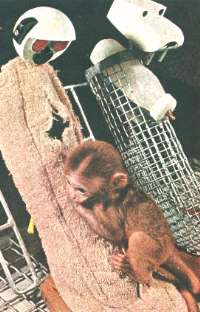

 |
By Silvia Helena Cardoso, PhD |
The position commonly held by psychologists and sociologists is clear: The basic motives are, for the most part, the primary drives -- particularly hunger, thirst, elimination, and pain -- and all other motives, including love or affection, are derived or secondary drives. The mother is associated with the reduction of the primary drives -- particularly hunger, thirst, and pain -- and through learning, affection or love is derived (1).
Harry F. Harlow, a psychologist at the
University of Wisconsin, demonstrated the importance of contact comfort
in attachment. He was among the first to find that rhesus monkeys
become unusually aggressive when raised in isolation.

The baby monkey sucks on the nipple of a surrogate mother made of wire, but later expends most of its time attached to the "mother" made of cloth, thus demonstrating a strong preference for heat and comfort more similar to its natural mother. |

The young monkey at right grew without contact with a mother and without play companions of its age. When another young monkey approaches, it becomes scared and runs away, thus evidencing the effect of an abnormal raising. |

Easily dominated by others, the abnormal monkey is unable to defend itself and even to play. The conclusions of these experiments have demonstrated that the contact with other siblings is vital for normal psychological development in primates. Photos
by Nina Leen
|
In order to study the development of affectional responses of neonatal and infant monkeys, Harlow separated baby monkeys from their mothers after birth. In his experiments, each baby had access to two artificial, inanimate mothers, one of them made out of a naked wire frame with a wooden face and a mik bottle at breast level; and another fashioned out in the same way, but covered by warm cloth pads (folded gauze diapers). The babies stayed with both "mothers", but as they were growing up, they showed strong attachment to the cloth mother. When threatened by a strange stimulus introduced into the cage, for example, a mechanical bear, they ran away to the cloth "mother", grabbed it in close proximity, and then, comforted and without fear, examined the toy. In the same way, when placed in a strange room, they immediately sought after the cloth "mother" e made contact before exploring the new environment. The baby monkeys who where created without their real mother or the cloth surrogate mothers were incapable of normal social relations, later in life. Harlow was impressed by the possibility that, above and beyond the bubbling fountain of breast or bottle, contact comfort might be a very important variable in the development of the infant's affection for the mother.
This research is critical because it links
animal studies with those performed in clinical research. Using the rhesus
monkey provides similarities to humans in brain structure, social behavior,
and response to stress.
The
Author
|
To
know more:
The Nature of Love Primate Studies Laboratory The Biological Bases of Positive Affective Styles |